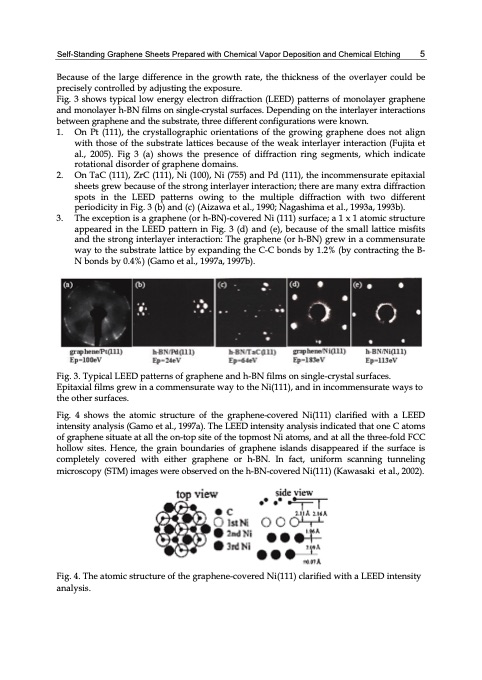
PDF Publication Title:
Text from PDF Page: 015
Self-Standing Graphene Sheets Prepared with Chemical Vapor Deposition and Chemical Etching 5 Because of the large difference in the growth rate, the thickness of the overlayer could be precisely controlled by adjusting the exposure. Fig. 3 shows typical low energy electron diffraction (LEED) patterns of monolayer graphene and monolayer h-BN films on single-crystal surfaces. Depending on the interlayer interactions between graphene and the substrate, three different configurations were known. 1. On Pt (111), the crystallographic orientations of the growing graphene does not align with those of the substrate lattices because of the weak interlayer interaction (Fujita et al., 2005). Fig 3 (a) shows the presence of diffraction ring segments, which indicate rotational disorder of graphene domains. 2. On TaC (111), ZrC (111), Ni (100), Ni (755) and Pd (111), the incommensurate epitaxial sheets grew because of the strong interlayer interaction; there are many extra diffraction spots in the LEED patterns owing to the multiple diffraction with two different periodicity in Fig. 3 (b) and (c) (Aizawa et al., 1990; Nagashima et al., 1993a, 1993b). 3. The exception is a graphene (or h-BN)-covered Ni (111) surface; a 1 x 1 atomic structure appeared in the LEED pattern in Fig. 3 (d) and (e), because of the small lattice misfits and the strong interlayer interaction: The graphene (or h-BN) grew in a commensurate way to the substrate lattice by expanding the C-C bonds by 1.2% (by contracting the B- N bonds by 0.4%) (Gamo et al., 1997a, 1997b). Fig. 3. Typical LEED patterns of graphene and h-BN films on single-crystal surfaces. Epitaxial films grew in a commensurate way to the Ni(111), and in incommensurate ways to the other surfaces. Fig. 4 shows the atomic structure of the graphene-covered Ni(111) clarified with a LEED intensity analysis (Gamo et al., 1997a). The LEED intensity analysis indicated that one C atoms of graphene situate at all the on-top site of the topmost Ni atoms, and at all the three-fold FCC hollow sites. Hence, the grain boundaries of graphene islands disappeared if the surface is completely covered with either graphene or h-BN. In fact, uniform scanning tunneling microscopy (STM) images were observed on the h-BN-covered Ni(111) (Kawasaki et al., 2002). Fig. 4. The atomic structure of the graphene-covered Ni(111) clarified with a LEED intensity analysis.PDF Image | GRAPHENE SYNTHESIS CHARACTERIZATION PROPERTIES

PDF Search Title:
GRAPHENE SYNTHESIS CHARACTERIZATION PROPERTIESOriginal File Name Searched:
Graphene-Synthesis.pdfDIY PDF Search: Google It | Yahoo | Bing
Salgenx Redox Flow Battery Technology: Power up your energy storage game with Salgenx Salt Water Battery. With its advanced technology, the flow battery provides reliable, scalable, and sustainable energy storage for utility-scale projects. Upgrade to a Salgenx flow battery today and take control of your energy future.
| CONTACT TEL: 608-238-6001 Email: greg@infinityturbine.com | RSS | AMP |